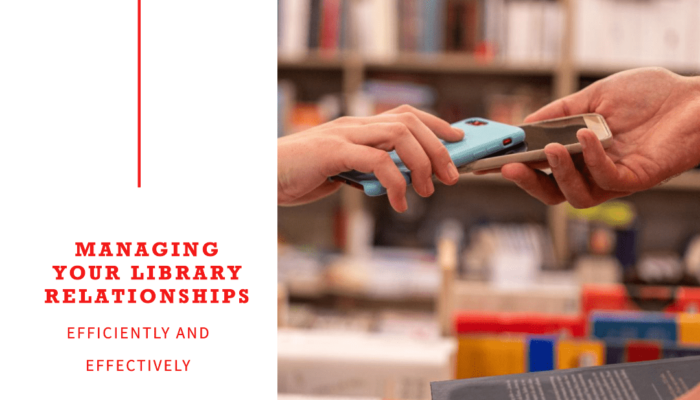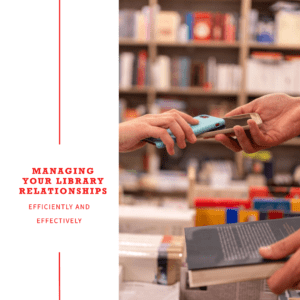This month, Trevor Deck walks us through the library’s collection development mandates, scope and goals.

Customer relationship management for readers’ advisory
This is the story of developing a strategy to bring active readers’ advisory services to a community locked out of access to library browsing during COVID-19.
Background
The summer of 2020 was an extraordinary time for those working in Ontario public libraries. We had permission from the provincial government to reopen after being closed since mid-March. Our in-person services were limited to providing curbside pickup of items on loan.
We all faced a steep learning curve as we developed a curbside service model that best suited our communities. At the library where I work (a single branch system in a community with a population of 35,000), 2020 was a summer of innovation as we constantly honed our curbside processes for efficiency, safety, and high-quality service.
One downside of curbside-only service became clear very quickly: patrons needed a way to browse in the library. Our library leaned heavily on displays and merchandising to promote our newest arrivals. For many of our patrons, browsing our collections and shelves is their primary method of selecting items to borrow.
Some of our browsing patrons could pivot to selecting and reserving items using our online catalogue. This was not an option for those without internet or those for whom using the catalogue was unfamiliar or uncomfortable.
Over the summer of 2020, we often heard from these patrons who were frustrated at the lack of browsing opportunities. In response, we ramped up our production of print booklists promoting new titles. A selection of these was included in every curbside pickup bundle.
In addition, on my remote working days, I would call the patrons who had left us phone messages. These people often wanted something to read, but they had no specific title in mind. During these conversations, I would conduct readers’ advisory interviews to place items on hold for them to pick up curbside. I took lots of notes about preferences for genre and favourite authors. For some, I would offer to put items on hold regularly. Others preferred to contact me when they were ready for more.
As the summer went on, I kept track of which items I’d already reserved for each patron, so I would know not to reserve them again. I built up a folder full of notes, mostly handwritten. The system was unsustainable but worked on a day-to-day basis.

Luckily for me and my primitive system, the library reopened at the end of August 2020. My patrons were delighted to return to browsing. I packed away my notes. But the idea of this service model stayed with me.
This impromptu personalized service had some compelling by-products:
- Like conventional merchandising, this was away to promote items to patrons they would otherwise have been unaware of.
- It enabled me to meet (at least by phone or email) and connect personally with some patrons who really benefitted from a custom service model.
- In some cases, after Curbside 1.0 ended, I continued to promote new items to these patrons by email, based on my knowledge of their preferences.
Curbside 2.0
As Fall 2020 rolled on, we might likely return to curbside-only service. By this time, we had an entire staff complement back at work. Our Information Services team began planning for a full rollout of custom service for browsing-dependent patrons, just in case. We called this our Customer Relationship Management system, or CRM.
A CRM is a database tool commonly used in sales to enable salespeople to track personal and business-related information about their customers. A review of the CRM regularly allows a salesperson to customize their sales pitches and product offerings to their customers. It provides a centralized place to keep that information. We’ve adopted that idea to refer to both the record of patrons and the service we offered them.
While developing our CRM approach, we discussed the following:
- Which CRM platform would we use for gathering our information?
- What standard information would we keep in the CRM?
- What statistics would we want to draw from the CRM?
- How would we promote the service to our patrons?
Platform
We needed something that was cloud-based so we could access it from any computer. We needed something with no additional cost and a platform that was easy to use. We also wanted it to be a system we could tweak as we went along.
After much discussion, we used a shared notebook in Microsoft OneNote. We have recently converted to being an Office 365 organization, and this was an excellent opportunity to use one of the collaborative tools offered in the Office 365 suite.
Standard information
OneNote is styled like a paper notebook. Users can divide the notebook into sections. The sections can be further subdivided into pages.
Our notebook was initially broken into two sections. We created a page for each patron enrolled in our service in one area. Here we kept track by date of which items had been reserved for them to prevent repeats. We also made notes about times of contact and valuable anything for other team members serving this patron.
In the second section, we kept weekly records of our interactions with patrons, including the contact method and how many holds had been placed for each interaction.
We added a third section to archive some earlier records as the months passed.
Statistics
We used the data in section two to supplement the statistics we gathered throughout the curbside process, to capture the nature and extent of our customer interactions. We were tracking curbside pickups, phone calls, chat contacts, automatic renewals, and (from the CRM) the number of holds placed on behalf of patrons. Without information about traffic in the building, public computer use, and in-person programming, these statistics gave information to our library board regarding the services we could provide to our patrons during the long period of curbside-only service.
Promotion
In advance of the provincial shutdown at the end of December 2020, we reached out to the patrons I had been serving during the summer to let them know we were ready to help them again with personalized service. Each team member also connected with patrons they knew to offer them the possibility of assistance with the selection of materials.
We created a quarter-page promotional card that we handed out to curbside patrons once the shutdown began. This briefly outlined the service and gave a central email address and phone number for contact. These cards proved very effective for recruiting new customers to our service.
Evaluation – customer and staff satisfaction
At its height, our CRM contained 40 active customers. Some were parents or caregivers of young children with voracious appetites for board and picture books. The rest were primarily seniors who needed help accessing and/or using our catalogue. On average, we placed 514 monthly reservations for our formal CRM patrons and others requesting our assistance.
As we wound up service in July 2021, we checked in with each of our CRM patrons to see if they’d like to continue or adapt the service. As I had seen in August 2020, most were happy to return to the library to browse and select their own items. A few patrons opted for continued service after the library reopened for browsing. During our windup conversations, we often hear how grateful our customers were for the CRM service.
Our Information Services Team also gained from the experience. We were able to build long-term relationships with those we served. Often in readers’ advisories, we recommend items to patrons based on an RA interview but never find out how well our suggestions satisfied the customer’s needs. With this service, we had opportunities to ask follow-up questions and to fine-tune our recommendations over time.
The development and implementation of the CRM presented an excellent experience of working collaboratively on a project for our team. The collaboration extended to the service delivery method, as all team members could access the information in the CRM so that we could serve a CRM patron efficiently.
One of the strategic goals of our library is to define ourselves as a community-led organization. The CRM initiative grew directly from feedback from our community about what they needed from us during curbside-only service.
Lessons learned – platform and scalability
Who could have predicted how long Ontario libraries would be restricted to curbside-only service in 2021? Our choice of OneNote for the CRM platform could have been better for a six-month shutdown. It is a complex platform to search, especially as our records got longer. In addition, there were sometimes errors in syncing when multiple users were working in the CRM simultaneously. Finally, it wasn’t easy to extract our monthly statistics from OneNote.
We have learned enough through our two iterations of curbside to design a much more robust CRM next time. A database with forms-based data entry would be ideal.
Our Information Services team is composed of five members. When we had 40 active customers, we worked to fulfill all the selections and reservations. We could only have managed a few more customers than that. Our project has demonstrated the value of building personal relationships with our patrons and offering customized service. To scale up the service beyond 2021 levels, we’d need to recruit assistance from other staff members.
Future potential for the CRM service
We can see the applicability of the CRM model for our Homebound service customers. We could also market the service to parents, caregivers, and teachers. A good CRM platform could also be helpful if we develop a subscription box service. As the trend towards personalized service builds in libraries and retail, the CRM model will form a good foundation for doing service.

